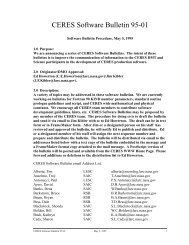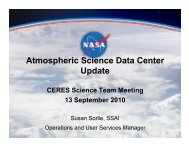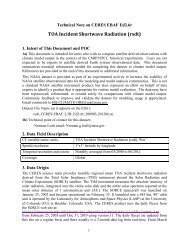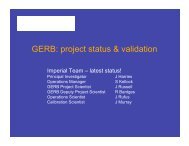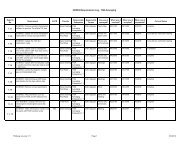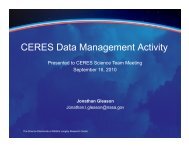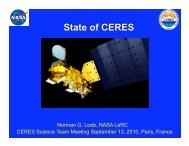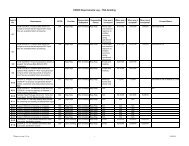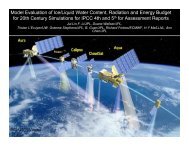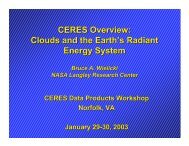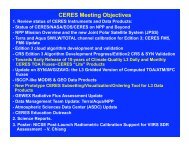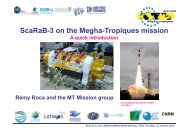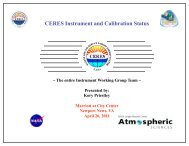Surface Longwave Radiative Fluxes (LRF ... - ceres - Nasa
Surface Longwave Radiative Fluxes (LRF ... - ceres - Nasa
Surface Longwave Radiative Fluxes (LRF ... - ceres - Nasa
You also want an ePaper? Increase the reach of your titles
YUMPU automatically turns print PDFs into web optimized ePapers that Google loves.
<strong>Surface</strong> <strong>Longwave</strong> <strong>Radiative</strong> <strong>Fluxes</strong> (<strong>LRF</strong>)<br />
comparisons between <strong>Surface</strong> <strong>Radiative</strong> Budget<br />
(SRB) and the CALIPSO-CloudSat-CERES-<br />
MODIS (CCCM{C3M}) during 2006-2007 <br />
Fall CERES Science Team Meeting <br />
October 4-6, 2011 <br />
Lawrence Livermore National Laboratory (LLNL) <br />
Livermore, CA <br />
Antonio Viudez-Mora, PhD <br />
NASA Langley Research Center
<strong>Surface</strong> <strong>Longwave</strong> <strong>Radiative</strong> <strong>Fluxes</strong> (<strong>LRF</strong>) comparisons between<br />
<strong>Surface</strong> <strong>Radiative</strong> Budget (SRB) and the CALIPSO-CloudSat-<br />
CERES-MODIS (CCCM{C3M}) during 2006-2007<br />
• Introduction <br />
• Objectives and methodology <br />
• NASA/GEWEX SRB LW & LPLA <br />
• CALIPSO-CloudSat-CERES-MODIS (C3M) <br />
• Zonal comparisons <br />
• Conclusions and future work <br />
NASA Langley Research Center <br />
Science Mission Directorate
Introduction: The Global Energy Budget <br />
Trenberth et al. 2009<br />
NASA Langley Research Center <br />
Science Mission Directorate
Introduction: Uncertainties in the<br />
Downward LW <strong>Fluxes</strong><br />
Importance of the Downward LW <strong>Fluxes</strong> <br />
Globally averaged DLF estimated: 333 – 350 Wm-2 <br />
[Trenberth et al. 2009, Kato et al. 2009, etc] <br />
Uncertainties in the closure of the global energy budget <br />
Uncertainty with in global and regional <strong>LRF</strong> assessments. <br />
Primary Sources of Uncertainty of DLF: <br />
Very sensitive to T and RH boundary layer <br />
Cloud properties: Height and thickness of the lowest cloud layer. <br />
Atmospheric Gaseous Constituents, including GHG. <br />
NASA Langley Research Center <br />
Science Mission Directorate
Objectives and Methodology <br />
• Assess the uncertainties and variability of long-term surface LW<br />
fluxes: <br />
– What is the overall uncertainty in the global annual DLF and Net LW? <br />
– Can the observed variability be explained? <br />
– Is there evidence of long-term changes that emerge above this uncertainty? <br />
– What is required to reduce the uncertainties in the long-term record? <br />
• Address these objectives by: <br />
– Comparing currently available satellite LW flux data sets: <br />
• NASA/GEWEX SRB LW now spanning nearly 25 years <br />
• CERES and CALIPSO-CloudSat-CERES-MODIS (C3M) <br />
- Compare satellite and ground-base measurements using tools for various case<br />
studies. <br />
• Use BSRN and ARM surface measurements <br />
• Provide an assessment of current surface radiative fluxes retrievals<br />
including identification of needs. <br />
NASA Langley Research Center <br />
Science Mission Directorate
NASA/GEWEX <strong>Surface</strong> Radiation Budget LW<br />
Release 3 Flux Algorithms <br />
• Data Set Description:<br />
The NASA/GEWEX <strong>Surface</strong> Radiation Budget (SRB) data sets contains global 3-<br />
hourly, daily, monthly/3-hourly, and monthly averages of surface and top-of<br />
atmosphere (TOA) longwave and shortwave radiative parameters on a 1°x1° grid. <br />
• Primary Inputs <br />
• Visible and infrared radiances and cloud property retrievals from International<br />
Satellite Cloud Climatology Project (ISCCP DX). <br />
• Temperature and moisture profiles from GEOS-4 reanalysis product obtained<br />
from the NASA Global Modeling and Assimilation Office (GMAO) <br />
• Skin temperatures from GEOS-4 and/or ISCCP <br />
• Column ozone from TOMS, TOVS, and SMOBA <br />
• Ancillary IGBP surface vegetation and CERES surface emissivity <br />
• Monthly CO 2 concentration values, based on monthly trend values from NOAA <br />
NASA Langley Research Center <br />
Science Mission Directorate
NASA/GEWEX <strong>Surface</strong> Radiation Budget LW<br />
Release 3 Flux Algorithms <br />
• LW Algorithms: <br />
• LW algorithm is an adaptation of Fu et al., (JAS,<br />
Vol. 54, 2799-2812, 1997) <br />
• Uses Maximum overlap within ISCCP layers<br />
of High, Middle Low cloud classes and<br />
random overlap between those classes <br />
• Langley Parameterized LW Algorithm – LPLA<br />
(Gupta et al) [former Quality Check]. <br />
• ~25 years of data (July 1983 through Dec 2007) <br />
NASA Langley Research Center <br />
Science Mission Directorate
The CALIPSO-CloudSat-CERES-MODIS (CCCM<br />
{C3M}) Data Set<br />
1. Merged CALIPSO, CloudSat derived clouds, CERES TOA radiative flux (SW, LW, and WN),<br />
MODIS (CERES_ST) derived cloud properties both along CALIPSO-CloudSat ground-track<br />
and over the whole CERES footprint,<br />
2. MODIS derived cloud properties by an enhanced cloud algorithm,<br />
3. CALIPSO and MODIS derived aerosol properties <br />
4. Vertical radiative flux profiles computed with CALIPSO, CloudSat, and MODIS derived<br />
cloud properties. <br />
5. Uses modified Fu/Liou based algorithm (FLKRR) <br />
• 44 months of data (July 2006 through Feb. 2010) <br />
~20 km <br />
MODIS pixels<br />
(1km) <br />
CERES<br />
footprint <br />
CALIPSO CloudSat <br />
ground track <br />
NASA Langley Research Center <br />
Science Mission Directorate
Comparisons of GEWEX SRB to<br />
CCCM LW <strong>Fluxes</strong> <br />
• Comparison between NASA/GEWEX SRB LW & LPLA and<br />
CCCM during 12 months (January to December 2007). <br />
– NASA/GEWEX SRB LW & LPLA monthly averaged from 3 hourly.<br />
– CCCM monthly averaged from daily data files. <br />
NASA Langley Research Center <br />
Science Mission Directorate
Global comparisons of Downward LW Flux <br />
Units (Wm -‐2 ) Mean Stdev <br />
CCCM 345.5 59.1 <br />
GEWEX/SRB 343.1 60.1 <br />
LPLA 346.0 62.3 <br />
NASA Langley Research Center <br />
Science Mission Directorate
Seasonally Averaged Zonal Comparisons of<br />
GEWEX SRB and CCCM DLW <strong>Fluxes</strong> <br />
NASA Langley Research Center <br />
Science Mission Directorate
Monthly Averaged Zonal Comparisons of<br />
GEWEX SRB and CCCM DLW <strong>Fluxes</strong> <br />
GLW – C3M<br />
LPLA – C3M<br />
NASA Langley Research Center <br />
Science Mission Directorate
Global comparisons of GEWEX SRB and CCCM<br />
ULW <strong>Fluxes</strong> <br />
Units (Wm -‐2 ) Mean Stdev <br />
CCCM 398.4 67.7 <br />
GEWEX/SRB 396.3 68.5 <br />
LPLA 397.2 67.8 <br />
NASA Langley Research Center <br />
Science Mission Directorate
Seasonally Averaged Zonal Comparisons of<br />
GEWEX SRB and CCCM ULW <strong>Fluxes</strong> <br />
NASA Langley Research Center <br />
Science Mission Directorate
Monthly Averaged Zonal Comparisons of<br />
GEWEX SRB and CCCM ULW <strong>Fluxes</strong> <br />
GLW – C3M<br />
LPLA – C3M<br />
NASA Langley Research Center <br />
Science Mission Directorate
<strong>Surface</strong> <strong>Longwave</strong> <strong>Radiative</strong> <strong>Fluxes</strong> (<strong>LRF</strong>) comparisons between<br />
<strong>Surface</strong> <strong>Radiative</strong> Budget (SRB) and the CALIPSO-CloudSat-<br />
CERES-MODIS (CCCM{C3M}) during 2006-2007<br />
• Conclusions: <br />
– The differences between GEWEX, LPLA and C3M are mainly at polar regions are most<br />
likely mainly due to the different cloud properties in SRB relative to CCCM. <br />
• Tropical differences between LPLA and C3M could be due to assumptions of cloud<br />
base that the max/random overlap assumption in GLW partially accounts for <br />
• The differences for the upward fluxes is in the difference in the skin temperatures.<br />
- GLW uses ISCCP blended with GEOS-4.<br />
- LPLP and CCCM use only GEOS-4; that’s why they are closer.<br />
• More analysis is needed to assess <br />
– The difference between GEWEX-NASA SRB and CC3M was done based on different<br />
time base. GEWEX-NASA from 3 hourly and covering all the planet, meanwhile C3M<br />
from daily files which do not cover all the Earth’s surface.<br />
NASA Langley Research Center <br />
Science Mission Directorate
<strong>Surface</strong> <strong>Longwave</strong> <strong>Radiative</strong> <strong>Fluxes</strong> (<strong>LRF</strong>) comparisons between<br />
<strong>Surface</strong> <strong>Radiative</strong> Budget (SRB) and the CALIPSO-CloudSat-<br />
CERES-MODIS (CCCM{C3M}) during 2006-2007<br />
• Future work: <br />
– Asses the zonal difference GEWEX/NASA SRB LW and LPLA with C3M for TOA fluxes. <br />
– Asses the zonal cloud properQes for both databases (CF, cloud base height, cloud top <br />
height). <br />
– Asses the surface LW cloud radiaQve forcing. <br />
– Process and analyze CCCM data for land/ocean and day/night zonal averages and <br />
compare with 3 hourly GEWEX-‐SRB and LPLA <strong>LRF</strong>. <br />
NASA Langley Research Center <br />
Science Mission Directorate
<strong>Surface</strong> <strong>Longwave</strong> <strong>Radiative</strong> <strong>Fluxes</strong> (<strong>LRF</strong>) comparisons between<br />
<strong>Surface</strong> <strong>Radiative</strong> Budget (SRB) and the CALIPSO-CloudSat-<br />
CERES-MODIS (CCCM{C3M}) during 2006-2007<br />
• Future work: <br />
Compare these GEWEX /NASA SRB data set with CCCM <br />
• assess differences and look for areas with large differences associate with surface <br />
sites <br />
Assemble case studies using the results of the satellite comparisons above <br />
• assess atmospheric trace gas, cloud and aerosol property differences relaQve to the <br />
downward flux <br />
• assess areas of greatest improvement potenQal <br />
NASA Langley Research Center <br />
Science Mission Directorate
Thanks for your attention <br />
NASA Langley Research Center <br />
Science Mission Directorate
Extras
<strong>Surface</strong> <strong>Longwave</strong> <strong>Radiative</strong> <strong>Fluxes</strong> (<strong>LRF</strong>) comparisons between<br />
<strong>Surface</strong> <strong>Radiative</strong> Budget (SRB) and the CALIPSO-CloudSat-<br />
CERES-MODIS (CCCM{C3M}) during 2006-2007<br />
• NASA/GEWEX SRB LW & LPLA (cont.) <br />
• The release 3.0 version includes: <br />
• Improved cloud properties in areas in missing and sun glint regions where<br />
ISCCP cloud retrievals aren't performed.<br />
• The IR radiative parameterization of ice clouds has been updated (Fu et al.<br />
1998).<br />
• Update water vapor continuum (Kratz and Rose, 1999).<br />
• An error in the ozone profile assignment is corrected.<br />
• The surface vegetation type maps updated, affecting the surface emissivity<br />
values (Rutan et al. 2009).<br />
• Monthly CO 2 concentration values, based on monthly trend values <br />
NASA Langley Research Center <br />
Science Mission Directorate
<strong>Surface</strong> <strong>Longwave</strong> <strong>Radiative</strong> <strong>Fluxes</strong> (<strong>LRF</strong>) comparisons between<br />
<strong>Surface</strong> <strong>Radiative</strong> Budget (SRB) and the CALIPSO-CloudSat-<br />
CERES-MODIS (CCCM{C3M}) during 2006-2007<br />
• CCCM (CALIPSO-CloudSat-CERES-MODIS ) <br />
Funded by the NASA Energy Water Cycle Study (NEWS) project. <br />
Provide a global data set along the lidar/radar ground track with the most accurate and<br />
comprehensive aerosol properties, cloud properties, and vertical radiative flux profiles. <br />
Improvement in different study areas: <br />
<br />
<br />
<br />
<br />
<br />
Assimilation and prediction by global aerosol models through better understanding of<br />
aerosol layer location.<br />
Understanding of multi-layered and polar cloud systems and their radiative impacts. <br />
Better understanding of frequency of occurrence of thin cirrus and boundary layer clouds<br />
and their radiative impacts <br />
Error assessment of cloud and aerosol properties derived from passive instruments and<br />
irradiances computed with them <br />
Better estimate of surface and atmospheric radiation budget <br />
NASA Langley Research Center <br />
Science Mission Directorate



